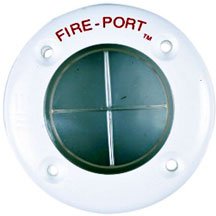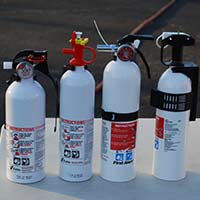That was a Little Scary - Fire Extinguisher Tests
Foundation Findings #46 - May 2009
Overview
Not much has changed since 1988, when the Foundation first tested fire extinguishers. There was quite a bit of déjà vu going around as we set up the tests in the same place that the original tests had been done.
The Coast Guard minimum requirements have not changed and the way fire extinguishers are rated follows the same standards. Our recommendation from 1988, to have tri-class (1A:10BC) fire extinguishers onboard your boat, and to have more than the Coast Guard requirements still stands as our best advice. But what's different this time around you ask? Why go to the trouble to test fire extinguishers again?
One word - VIDEO. This time we captured every second of every fire on video to show you exactly what you can expect if you ever have to use a fire extinguisher. Never before have we been able to bring you this close to the action of fighting a fire on your boat. If a picture is worth 1,000 words, then a 30-second video must be worth a library.
The Shopping List - Fire Extinguishers
There are two purchasing criteria for fire extinguishers with which boaters need to be concerned: Is it U.S. Coast Guard approved and what is the Underwriter's Laboratory (UL) classification? For our test, we looked at the most common fire extinguishers found on recreational boats: U.S. Coast Guard approved B-1 models that are rated for A, B, or C fires.
For more information on approvals, rating systems and minimum requirements of fire extinguishers please view our Boating Safety Study Guide. Here's a list of the units we tested:
5-B:C Models - U.S. Coast Guard Approved B-1, UL Classified 5-B:C, Dry Chemical Retardant
- Kidde PWC, Retail Price $22.99
- First Alert Mini Marine Fire Extinguisher PWC, $64.79 (4 pack)
- Kidde Mariner 5, $27.99
- First Alert Mini Marine Fire Extinguisher, $29.99
10-B:C Models - U.S. Coast Guard Approved B-1, UL Classified 10-B:C, Dry Chemical Retardant
- Kidde Mariner 10, $27.99
- First Alert Marine Fire Extinguisher, $29.99
1-A:10-B:C Models - U.S. Coast Guard Approved B-1, UL Classified 1-A:10-B:C, Dry Chemical Retardant
- Kidde Mariner 110, $33.99
- First Alert Multipurpose Marine Fire Extinguisher, $116.53 (4 pack)
Halon Replacement - U.S. Coast Guard Approved B-1
- Kidde Halotron 1 - 5-B:C, $184.99
- Kidde Halotron 1 - 1-A:10-B:C, $354.99
Kidde products are available at Westmarine and Defender. First Alert products are available at Amazon and Ace Hardware.

Proper Procedures
We observed 18 inexperienced volunteers attempt to put out fires with 10 test units. What we found was that in the heat of the moment reading the directions on the extinguisher was an after-thought. As a result, improper technique was the norm. The take home point is to know how to use a fire extinguisher before you are in a situation where you have to use it.
Fire extinguishers are labeled according to the type of fire on which they may be used. Fires involving wood or cloth, flammable liquids, electrical current or a combination of those will each react differently to extinguishers. Using the wrong type of extinguisher on a particular type of fire could be dangerous and make matters even worse.
Simply Remember the P-A-S-S Word!
- Pull the pin at the top of the cylinder
- Aim the nozzle at the base of the fire
- Squeeze or press the handle
- Sweep the contents from side to side at the base of the fire until it goes out
Fire Extinguishers Close-Up
Firing Mechanism
All extinguishers have pins or pull tabs that have to be removed to activate the unit. plastic tie This feature prevents false activations. Some of our testers had difficulty removing the pin because it was held in by a thin sacrificial plastic tie.
We found most extinguishers had two levers that are squeezed together to activate. This is in contrast to the smaller 5-BC units designed for personal watercraft, which use a more simplified firing mechanism. Kidde uses a plunger mechanism and First Alert uses a trigger to activate their unit. Both are designed so that the firing mechanism does not extend past the width of the cylinder.

Guages
There is a gauge on most extinguishers to measure the pressure of its contents. A fire gauges extinguisher can be "overcharged" meaning the contents are under too much pressure, "discharged" meaning that there is not enough pressure to work correctly or "in the green" which means that the unit is properly charged.
The standard round gauge was found on all but the personal watercraft units. Over time, or after it has been used, a fire extinguisher will loose pressure and will cease to work properly.
Most of our test extinguishers were not rechargeable. A rechargeable extinguisher can be taken to a service station for maintenance. If it is not rechargeable then it should be discarded when the gauge reads "discharged" or it has been in service for 12 years from manufacture.
Partial Discharge
Fire extinguishers are designed to rapidly release fire retardant onto their target. partial discharge when activated, the firing mechanism pierces a gas cylinder exerting additional pressure in the cylinder propelling the retardant out of the open nozzle. During our test we found that a partially discharged dry chemical extinguisher was inoperable after a few minutes. If you have a flare up after several minutes, a partially discharged unit might not work. It is important to replace or service the extinguisher as soon as possible.
Extinguisher Contents
Dry Chemical Extinguisher
The economically priced, handheld dry chemical fire extinguishers are the most common type found aboard recreational boats. The retardant functions by coating the material on fire and removing the oxygen from the flame similar to throwing a fire blanket on a fire. An accurate aim at the base of the fire directs the retardant at the source. Sometimes our testers found that by aiming at the top or middle of the fire, they could not put out the fire completely, and frequently required an additional extinguisher to finish the job. Clean up of dry chemical extinguishers can be messy and it is corrosive to electronic components and wiring.
Halon Replacement Extinguishers
During our test we looked at two Halotron fire retardant extinguishers. There are also two other halon replacement retardants legal in the U.S: FE-241 and FM-200. hese three chemicals were developed as "clean" fire suppression agents since Halon 1301 was discontinued. Our test of the Kidde Halotron models demonstrated the benefits and shortcomings of halon replacement extinguishers.
Unlike dry chemical extinguishers, the Halotron extinguisher displaces oxygen from the fire. This gaseous fire suppressant allows for easy sight of the fire and does not harm engine or electronic components. Halon replacement extinguishers are ideal for separated, enclosed spaces such as an engine compartments for use through a Fire-Port. All portable halon replacement units are safe to breath but fixed systems using FE-241 are not. Drawbacks for these fire extinguishers are the higher price and bulkier size.

Most of our test extinguishers were not rechargeable. A rechargeable extinguisher can be taken to a service station for maintenance. If it is not rechargeable then it should be discarded when the gauge reads 'discharged' or it has been in service for 12 years from manufacture.
What is Right for Me?
A tri-class dry chemical extinguisher will meet most boaters' needs. If you have concerns about damage to your electronics or your engine compartment lacks a fixed system, a strategically placed Halotron product could serve you well.
As fire extinguishers are required on most boats, you most likely have one aboard. But chances are, you've never needed to use one, and might not know the proper technique for using one.
Take the time to read the directions on your fire extinguisher - you might be surprised about what it can and can't do.
Testers' Choice

The Kidde and First Alert 1-A:10-B:C are the Foundation picks for best all around for the price. About $5 more per extinguisher will give you the added security when trying to put out a small fire aboard your boat.

